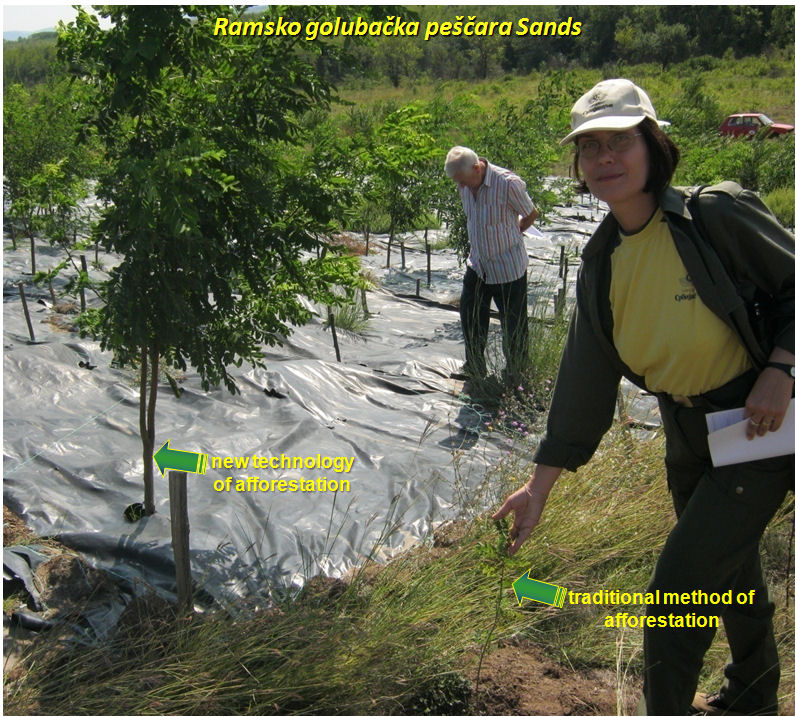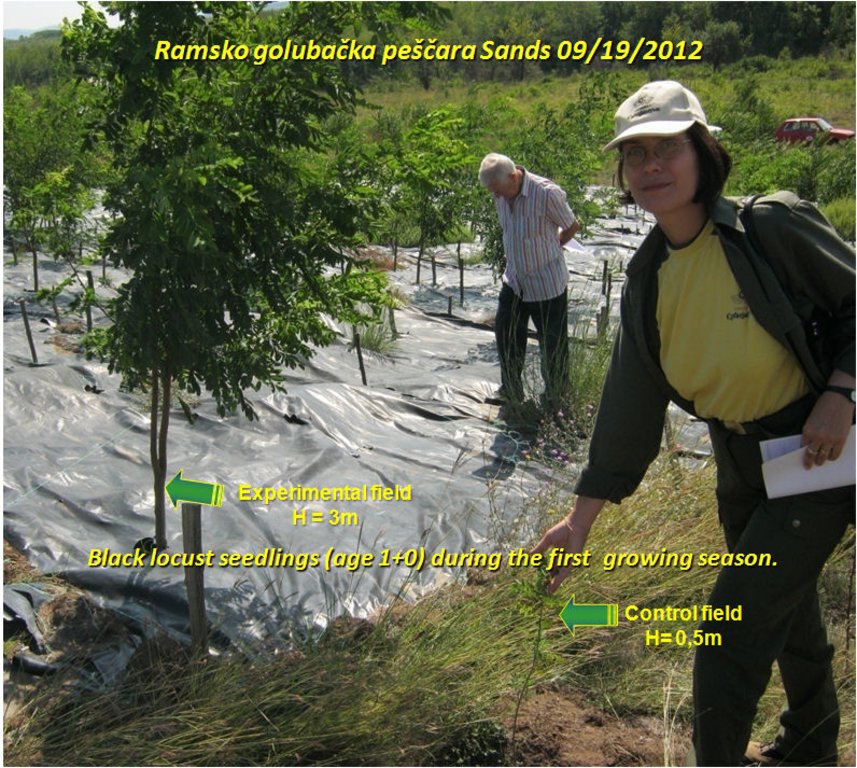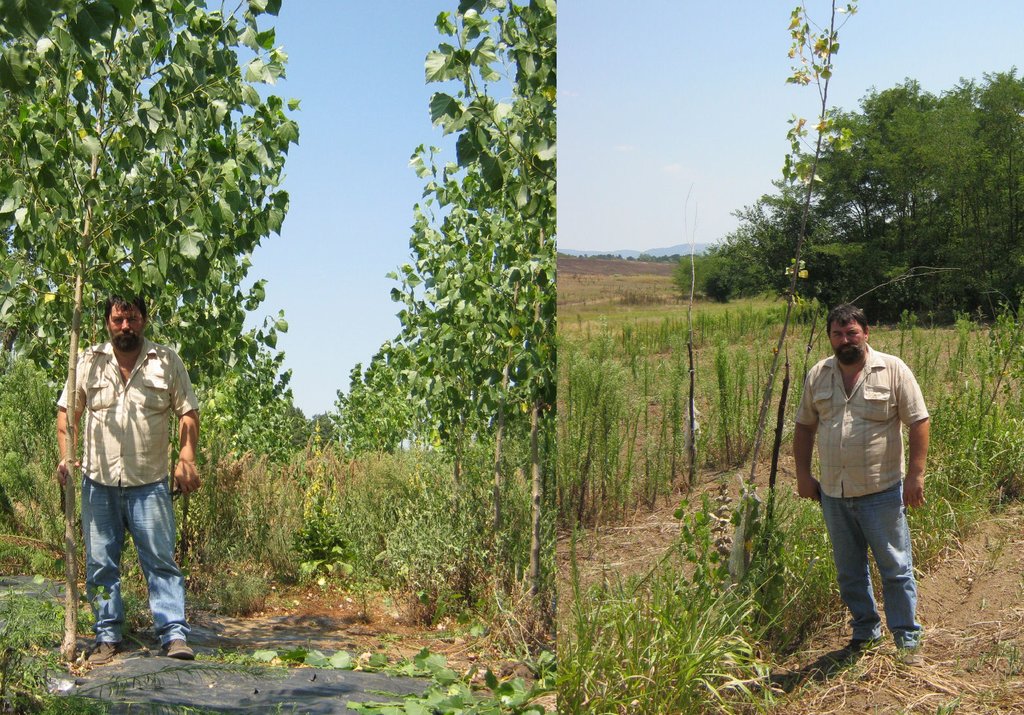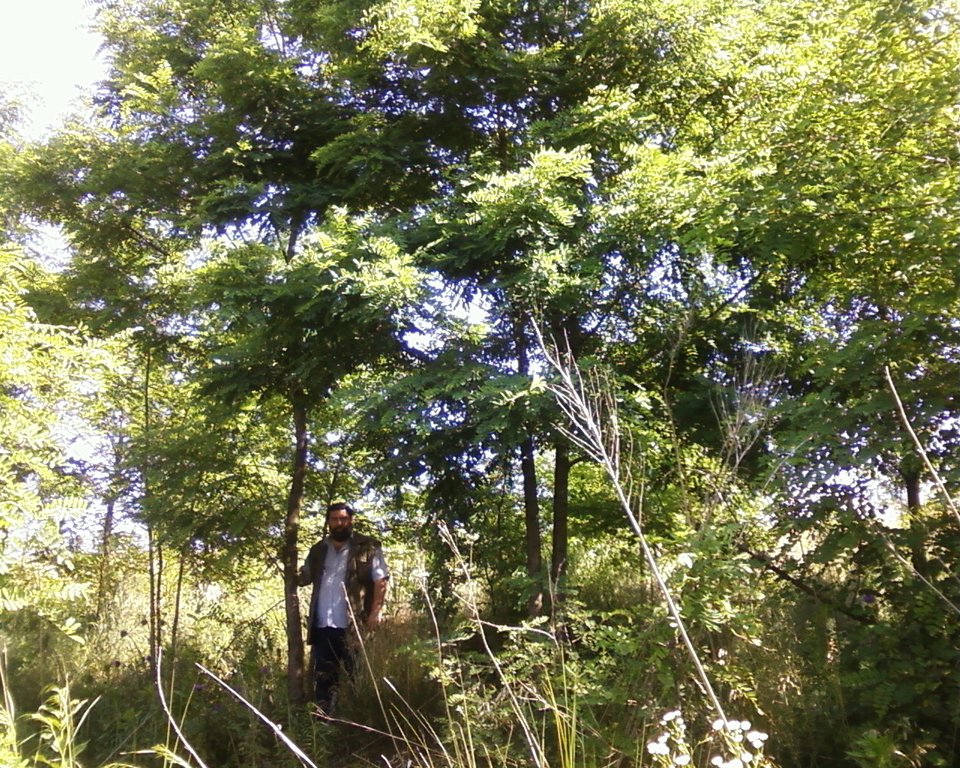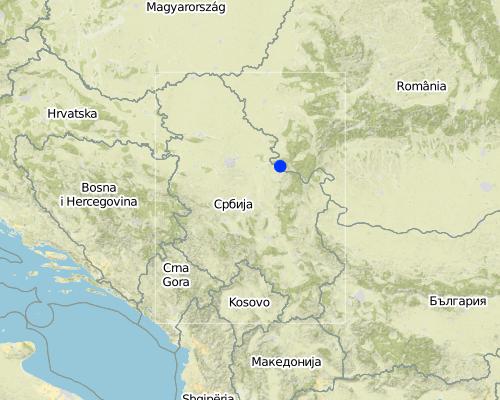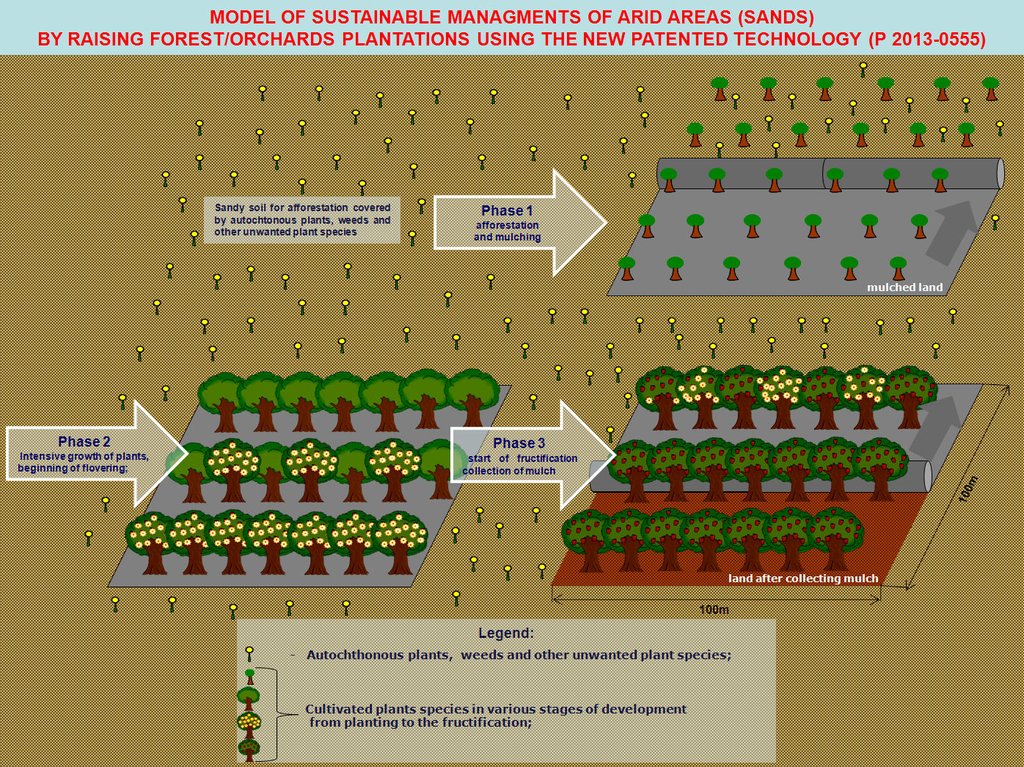New patented technology of raising forest and orchards in the extremely unfavorable environmental conditions [Serbie]
- Création :
- Mise à jour :
- Compilateur : Blagoje Pejić
- Rédacteur : –
- Examinateur : Alexandra Gavilano
The Procedure Complete Mulching of Land In Order to Raise Young Plantations of Woody Plants Under Unfavorable Climate Conditions P 2013 - 0555
technologies_500 - Serbie
Voir les sections
Développer tout Réduire tout1. Informations générales
1.2 Coordonnées des personnes-ressources et des institutions impliquées dans l'évaluation et la documentation de la Technologie
1.3 Conditions relatives à l'utilisation par WOCAT des données documentées
Quand les données ont-elles été compilées (sur le terrain)?
19/09/2012
Le compilateur et la(les) personne(s) ressource(s) acceptent les conditions relatives à l'utilisation par WOCAT des données documentées:
Oui
1.4 Déclaration sur la durabilité de la Technologie décrite
Est-ce que la Technologie décrite ici pose problème par rapport à la dégradation des terres, de telle sorte qu'elle ne peut pas être déclarée comme étant une technologie de gestion durable des terres?
Non
Commentaires:
This technology does not pollute the environment and completely excludes the use of chemical agents in the control of undesirable plant species.
2. Description de la Technologie de GDT
2.1 Courte description de la Technologie
Définition de la Technologie:
The technological process of complete mulching with specific materials (P 2013 – 0555) has a positive impact on the development, e.g. the growth intensity and the growth time of the cultivated plant species. This technology allows to grow plants without additional irrigation in rather poor habitat conditions (high temperature, insolation, etc.).
2.2 Description détaillée de la Technologie
Description:
1. This technology has been applied in arid conditions Ramsko golubačka peščara Sands (East Serbia). This semi deserts is one of three located in Serbia. As is known, all the ecosystems (agro, forest and water ecosystems) in the surrounding of sands and deserts are highly endangered by wind erosion, which causes movement and transport of the sand and damage to people, agronomy and biodiversity. This is poor area, inhabited by the Roma population - highly affected by the consequences of moving sands;
2. This process of complete mulching of land with specific polyethylene foil enables use of poor habitat conditions (high temperature, insolation and etc) tor a positive impact on the development of plants. This innovative technology provides fully use of the reserves of moisture and mineral matters in the soil, as well as intensification of the process of photosynthesis of cultivated plants, which are the main reasons for the rapid growth and exceptionally good overall condition of young plantations
3 The purpose of this technology is to increase success of the procedure and ensure the achievement of the targeted functionality of woody plants (binding and greening sands, ensuring of food and wind shelter for humans and wild animals, increasing biodiversity) in a much shorter period of time than traditional methods afforestation.
4. In relation to the works that follow the classical techniques to raise woody plants, for this patented technology is necessary to additionally provide a trained workforce for the setting up of mulch, specific material for mulching and license to use the patent. To establish this technology trained workforces are required to set up the specific materials for mulching, taking care of the plants, as well a license to use the patented technology must be acquired
5. Based on the principle “make it and leave it” this technological process enables the following conditions: no need for additional irrigation; no need for mechanical soil cultivation before afforestation; no need for additional manpower and works that are required in maintaining young forest plantations raised by classical methods of afforestation (hoeing, inter-row processing, harrowing, weeds and stump sprout removing...); in the next 3-5 years completely prevented the appearance of unwanted species of plants (weeds) without the use of chemicals; no environmental pollution; no soil erosion as well as rinsing and removal of humus on slopes; fructification of fruit tree species starting earlier, shelterbelts and snow protective belts are usable for far less time, the sands bind is faster, afforestation of degraded land and the process of rehabilitation and recultivation is shortened, production cycle of energy crops takes less time and give faster return on investment, binding of sands and stop wind erosion has a positive impact on the microclimate of whole sandy area and helps to increase the biodiversity as well as increase of yields of agricultural crop.
6. Although the cumulative amount of costs of implementing the patented technology is much lower compared to the works following the classic techniques to raise woody plants, an aggravating circumstance for the use of this technology may be the obligation to hold a license to use the patent and greater capital investment in the first year of plantation. Users especially likes fact that young plantations reaches the targeted purposes for drastically shorter time, without additional irrigation.
2.3 Photos de la Technologie
Remarques générales concernant les photos:
The pictures show the difference between the results of the use of traditional technology of afforestation and the use of new patented technologies of afforestation
2.5 Pays/ région/ lieux où la Technologie a été appliquée et qui sont couverts par cette évaluation
Pays:
Serbie
Région/ Etat/ Province:
Veliko Gradište
Autres spécifications du lieu:
Ramsko golubačka peščara Sands
Map
×2.6 Date de mise en œuvre de la Technologie
Si l'année précise est inconnue, indiquez la date approximative: :
- il y a moins de 10 ans (récemment)
2.7 Introduction de la Technologie
Spécifiez comment la Technologie a été introduite: :
- au cours d'expérimentations / de recherches
3. Classification de la Technologie de GDT
3.1 Principal(aux) objectif(s) de la Technologie
- améliorer la production
- réduire, prévenir, restaurer les terres dégradées
- préserver l'écosystème
- protéger un bassin versant/ des zones situées en aval - en combinaison avec d'autres technologies
- conserver/ améliorer la biodiversité
- réduire les risques de catastrophes
- s'adapter au changement et aux extrêmes climatiques et à leurs impacts
- atténuer le changement climatique et ses impacts
- créer un impact économique positif
- créer un impact social positif
3.2 Type(s) actuel(s) d'utilisation des terres, là où la Technologie est appliquée

Forêts/ bois
Plantations d'arbres, boisements:
- Variété locale en monoculture
- Variétés mixtes
- Forest fruits plantations
Produits et services:
- Bois de chauffage
- Fruits et noix
- Autres produits forestiers
- Conservation/ protection de la nature
3.3 Informations complémentaires sur l'utilisation des terres
Approvisionnement en eau des terres sur lesquelles est appliquée la Technologie:
- pluvial
Commentaires:
This technological process exclude additional irrigation and provide enough moisture for the life of cultivated plant species without the need for irrigation young plants, relying only on the water from atmospheric precipitates.
Nombre de période de croissance par an: :
- 1
3.4 Groupe de GDT auquel appartient la Technologie
- gestion des plantations forestières
- brise-vent/ plantations abris
- Amélioration de la couverture végétale/ du sol
3.5 Diffusion de la Technologie
Spécifiez la diffusion de la Technologie:
- répartie uniformément sur une zone
3.6 Mesures de GDT constituant la Technologie

structures physiques
- S6: Murs, barrières, palissades, clôtures
- S11: Autres
3.7 Principaux types de dégradation des terres traités par la Technologie

érosion hydrique des sols
- Wt: perte de la couche superficielle des sols (couche arable)/ érosion de surface

érosion éolienne des sols
- Et: perte de la couche superficielle des sols (couche arable)
- Ed: déflation et déposition
3.8 Prévention, réduction de la dégradation ou réhabilitation des terres dégradées
Spécifiez l'objectif de la Technologie au regard de la dégradation des terres:
- prévenir la dégradation des terres
- restaurer/ réhabiliter des terres sévèrement dégradées
Commentaires:
This is applicable model to combat desertification and sustainable management of Sands, using by the new technology of raising forest (and orchards) in arid areas, which ensure the achievement of the targeted functionality of woody plantations in a much shorter period of time than traditional methods afforestation, without additional irrigation, just relying on the existing atmospheric sediment
4. Spécifications techniques, activités, intrants et coûts de mise en œuvre
4.1 Dessin technique de la Technologie
4.2 Spécification/ explications techniques du dessin technique
This patented technological process of complete mulching of land enables use of poor habitat conditions (high temperature, insolation and etc.) for a positive impact on the intense growth and development of cultivated species of plants and provides, even in harsh environmental conditions, successful establishment of forest and orchards plantations, planting of new forests in areas where in the past did not exist and the conversion of stands of lower quality in higher silvicultural form, all without additional irrigation.
The news is a specific and layered process laying mulch and full coverage of land with specific, impermeable to water and light, synthetic materials over large areas. In this way, planted trees provides full access to the existing reserves of moisture and nutrients in the soil and suppress weeds, without the use of herbicides and pesticides and without the need for irrigation young plants, relying only on the water from atmospheric precipitates.
After completion of the production cycles, all the material used for mulching will be collected and recycled, which confirms that new technology has a zero degree of environmental pollution.
4.3 Informations générales sur le calcul des intrants et des coûts
Spécifiez la manière dont les coûts et les intrants ont été calculés:
- par superficie de la Technologie
Indiquez la taille et l'unité de surface:
1ha
autre/ monnaie nationale (précisez):
€ (Euro)
Indiquez le coût salarial moyen de la main d'œuvre par jour:
35€ (gross amount)
4.4 Activités de mise en place/ d'établissement
| Activité | Type de mesures | Calendrier | |
|---|---|---|---|
| 1. | Marking and measuring of places for planting | Agronomique | 2 workers (8hours) |
| 2. | Digging a hole for planting (40cm x 40 cm) | Agronomique | 11 workers (8hours) |
| 3. | Delivery seedlings | Agronomique | 4 workers (8hours) |
| 4. | Planting seedlings | Agronomique | 8 workers (8hours) |
| 5. | Placing (stacking) of mulch | Autres mesures | 12 workers (8hours) |
4.5 Coûts et intrants nécessaires à la mise en place
| Spécifiez les intrants | Unité | Quantité | Coûts par unité | Coût total par intrant | % des coût supporté par les exploitants des terres | |
|---|---|---|---|---|---|---|
| Main d'œuvre | workers | person - days | 37,0 | 35,0 | 1295,0 | |
| Main d'œuvre | skilled labor force | person - days | 3,0 | 100,0 | 300,0 | |
| Equipements | Machine hours | working hours | 10,0 | 15,0 | 150,0 | |
| Equipements | Tools | kom | 10,0 | 10,0 | 100,0 | |
| Matériel végétal | Seedlings | kom | 1300,0 | 1,0 | 1300,0 | |
| Engrais et biocides | Zeolite | kg | 910,0 | 0,32 | 291,2 | |
| Matériaux de construction | Material for mulching | square meter | 10000,0 | 0,22 | 2200,0 | |
| Autre | Licence | ha | 1,0 | 500,0 | 500,0 | |
| Autre | Transport of seedlings | Euro | 1300,0 | 0,01 | 13,0 | |
| Autre | Transport of workers | Euro | 37,0 | 0,7 | 25,9 | |
| Coût total de mise en place de la Technologie | 6175,1 | |||||
Commentaires:
The amount of the costs of raising young plantations (forest and orchard) refers to a period of 5 years, as planned duration of mulch. Based on the principle “make it and leave it”, during the period of duration of mulch, this technological process enables the following conditions: NO NEED for additional irrigation - provide enough moisture for the life of cultivated plant species without the need for irrigation young plants, relying only on the water from atmospheric precipitates; NO NEED for mechanical soil cultivation before afforestation; NO NEED for additional manpower and works that are required in maintaining young forest plantations raised by classical methods of afforestation (hoeing, inter-row processing, harrowing, weeds and stump sprout removing...). In the next 5 years completely prevented the appearance of unwanted species of plants (weeds) without the use of chemicals; NO environmental pollution; NO soil erosion as well as rinsing and removal of humus on slopes.
4.6 Activités d'entretien/ récurrentes
| Activité | Type de mesures | Calendrier/ fréquence | |
|---|---|---|---|
| 1. | Maintenance of mulch | Autres mesures | 3 workers (8hours) |
4.7 Coûts et intrants nécessaires aux activités d'entretien/ récurrentes (par an)
| Spécifiez les intrants | Unité | Quantité | Coûts par unité | Coût total par intrant | % des coût supporté par les exploitants des terres | |
|---|---|---|---|---|---|---|
| Main d'œuvre | workers | person - days | 3,0 | 35,0 | 105,0 | |
| Coût total d'entretien de la Technologie | 105,0 | |||||
5. Environnement naturel et humain
5.1 Climat
Précipitations annuelles
- < 250 mm
- 251-500 mm
- 501-750 mm
- 751-1000 mm
- 1001-1500 mm
- 1501-2000 mm
- 2001-3000 mm
- 3001-4000 mm
- > 4000 mm
Spécifiez la pluviométrie moyenne annuelle (si connue), en mm:
420,00
Spécifications/ commentaires sur les précipitations:
Precipitation are distributed unfavorably for the planted seedlings, given that the largest deficit was recorded in the middle of the growing season.
The sum of annual insolation (average for the period 1981-2010) = 2073.8h;
Average temperature (average for the period 1981-2010) = 11.3ºC
Indiquez le nom de la station météorologique de référence considérée:
Meteorological station Veliko Gradište
Zone agro-climatique
- semi-aride
According to Lang's classification, the researched area of Ramsko golubačka peščara Sands belongs into the category of semi arid climate areas (55.5)
5.2 Topographie
Pentes moyennes:
- plat (0-2 %)
- faible (3-5%)
- modéré (6-10%)
- onduleux (11-15%)
- vallonné (16-30%)
- raide (31-60%)
- très raide (>60%)
Reliefs:
- plateaux/ plaines
- crêtes
- flancs/ pentes de montagne
- flancs/ pentes de colline
- piémonts/ glacis (bas de pente)
- fonds de vallée/bas-fonds
Zones altitudinales:
- 0-100 m
- 101-500 m
- 501-1000 m
- 1001-1500 m
- 1501-2000 m
- 2001-2500 m
- 2501-3000 m
- 3001-4000 m
- > 4000 m
Indiquez si la Technologie est spécifiquement appliquée dans des:
- non pertinent
5.3 Sols
Profondeur moyenne du sol:
- très superficiel (0-20 cm)
- superficiel (21-50 cm)
- modérément profond (51-80 cm)
- profond (81-120 cm)
- très profond (>120 cm)
Texture du sol (de la couche arable):
- grossier/ léger (sablonneux)
Texture du sol (> 20 cm sous la surface):
- grossier/ léger (sablonneux)
Matière organique de la couche arable:
- moyen (1-3%)
Si disponible, joignez une description complète du sol ou précisez les informations disponibles, par ex., type de sol, pH/ acidité du sol, capacité d'échange cationique, azote, salinité, etc.
pH in KCL Depth 0-30cm = 5.98 (slightly acidic), Depth 30-60cm = 6.63 (neutrally);
CaCo3 (%) Depth 0-30cm = 0.00 (no carbonate), Depth 30-60cm = 0.00 (no carbonate);
Humus (%) Depth 0-30cm = 2.96 (low humus), Depth 30-60cm = 2.34 (low humus);
Nitrogen Depth 0-30cm = 0.148 (well supplied), Depth 30-60cm = 0.117 (well supplied);
P2O5 (mg/100gr) Depth 0-30cm = 5.99 (poor), Depth 30-60cm = 6.04 (poor);
K2O (mg/100gr) Depth 0-30cm = 7.50 (poor), Depth 30-60cm = 4.00 (poor);
5.4 Disponibilité et qualité de l'eau
Profondeur estimée de l’eau dans le sol:
5-50 m
Disponibilité de l’eau de surface:
moyenne
Qualité de l’eau (non traitée):
uniquement pour usage agricole (irrigation)
La salinité de l'eau est-elle un problème? :
Non
La zone est-elle inondée?
Non
5.5 Biodiversité
Diversité des espèces:
- faible
Diversité des habitats:
- faible
5.6 Caractéristiques des exploitants des terres appliquant la Technologie
Sédentaire ou nomade:
- Sédentaire
Orientation du système de production:
- subsistance (auto-approvisionnement)
Revenus hors exploitation:
- moins de 10% de tous les revenus
Niveau relatif de richesse:
- très pauvre
Individus ou groupes:
- individu/ ménage
Niveau de mécanisation:
- travail manuel
Genre:
- hommes
Age des exploitants des terres:
- personnes d'âge moyen
5.7 Superficie moyenne des terres détenues ou louées par les exploitants appliquant la Technologie
- < 0,5 ha
- 0,5-1 ha
- 1-2 ha
- 2-5 ha
- 5-15 ha
- 15-50 ha
- 50-100 ha
- 100-500 ha
- 500-1 000 ha
- 1 000-10 000 ha
- > 10 000 ha
Cette superficie est-elle considérée comme de petite, moyenne ou grande dimension (en se référant au contexte local)?
- moyenne dimension
5.8 Propriété foncière, droits d’utilisation des terres et de l'eau
Propriété foncière:
- état
- entreprise
Droits d’utilisation des terres:
- communautaire (organisé)
- individuel
Droits d’utilisation de l’eau:
- accès libre (non organisé)
- individuel
5.9 Accès aux services et aux infrastructures
santé:
- pauvre
- modéré
- bonne
éducation:
- pauvre
- modéré
- bonne
assistance technique:
- pauvre
- modéré
- bonne
emploi (par ex. hors exploitation):
- pauvre
- modéré
- bonne
marchés:
- pauvre
- modéré
- bonne
énergie:
- pauvre
- modéré
- bonne
routes et transports:
- pauvre
- modéré
- bonne
eau potable et assainissement:
- pauvre
- modéré
- bonne
services financiers:
- pauvre
- modéré
- bonne
6. Impacts et conclusions
6.1 Impacts sur site que la Technologie a montrés
Impacts socio-économiques
Production
production agricole
Quantité avant la GDT:
-3
Quantité après la GDT:
3
Commentaires/ spécifiez:
During studied period in the “Ramsko-Golubačka peščara” Sands, recorded seedling survival rate:
on the experimental area 80-100%;
on the control area 0-7%.
qualité des cultures
Quantité avant la GDT:
-2
Quantité après la GDT:
3
Commentaires/ spécifiez:
During studied period in the “Ramsko-Golubačka peščara” Sands, seedlings showed vigorous growth, a large amount of leaf mass, and excellent overall vitality of the plants, which the results are unusual even for a very good habitat!
on the experimental area H = 3m;
on the control area H = 0.5m
production de bois
Quantité avant la GDT:
-2
Quantité après la GDT:
3
Commentaires/ spécifiez:
In accordance with ecology cultivated species of trees - this technology, even in unfavorable habitats, enables faster growth of cultivated plant species, thus shortening the transition from plantations in the forest, and to achieve specific purposes, which indicates that the used method has success, even in harsh climates sands and deserts, where classical methods of afforestation does not give the desired results.
qualité des forêts/ bois
Quantité avant la GDT:
-3
Quantité après la GDT:
3
Commentaires/ spécifiez:
This new patented technology (P 2013-055) provides, even in the extremely harsh environmental conditions, better water and air regime of soil, which improves overall quality of the land and drastically increases the chances for success of the afforestation
surface de production
Quantité avant la GDT:
0
Quantité après la GDT:
3
Commentaires/ spécifiez:
This technology improves overall quality of the land
gestion des terres
Quantité avant la GDT:
-2
Quantité après la GDT:
2
Commentaires/ spécifiez:
The new technology of raising forest provides sustainable use of soils of lower quality (sands).
Revenus et coûts
disparités économiques
Quantité avant la GDT:
-1
Quantité après la GDT:
2
Commentaires/ spécifiez:
The cost of applying these technological methods of raising young seedlings were higher in the first year of life, but the cumulative costs, over a five-year maintenance period plantation tree species, is much lower than in traditional afforestation methods.
Autres impacts socio-économiques
Stop desertification
Quantité avant la GDT:
-3
Quantité après la GDT:
3
Commentaires/ spécifiez:
All the ecosystems (agro, forest and water ecosystems) near the deserts are highly endangered by different destructive processes, primarily by wind erosion. Wind erosion is a very destructive factor, causes movement and transport of the sand and consequential damages to people, agricultural crops and entire biodiversity. This is why the community in the Veliko Gradište (Eastern Serbia), especially people who are living on the periphery of the Ramsko golubačka peščara Sands - where themselves provide food (fruits of the forest) and job (forestry and agriculture), is highly affected by the consequences of moving sands.
This technology have a special significance for the wider community because it provides a successful model for stopping desertification and conservation/enhancement of biodiversity and protect settlements and agricultural crops from the negative effects of moving sands.
Impacts socioculturels
sécurité alimentaire/ autosuffisance
Quantité avant la GDT:
-1
Quantité après la GDT:
2
Commentaires/ spécifiez:
The new technology provides sustainable use of soils of lower quality (sands) by raising forest/orchards plantations and, in same time, provides food and wind shelter for humans and wild animals on the long-term period.
Impacts écologiques
Cycle de l'eau/ ruissellement
évaporation
Quantité avant la GDT:
-3
Quantité après la GDT:
3
Commentaires/ spécifiez:
Reduces the cost of water provide enough moisture for the life of cultivated plant species, without the need for irrigation young plants
Sols
humidité du sol
Quantité avant la GDT:
0
Quantité après la GDT:
3
Commentaires/ spécifiez:
This patented technology provides improvement of the water-air properties, Also, water retention of precipitation in the root zone of cultivated species is provided on the way that moisture is accessible only to the cultivated plants.
couverture du sol
Quantité avant la GDT:
-1
Quantité après la GDT:
3
Commentaires/ spécifiez:
This innovative technology provides a wider choice of high quality tree species for afforestation and creates conditions for sustainable use of sands.
perte en sol
Quantité avant la GDT:
0
Quantité après la GDT:
3
Commentaires/ spécifiez:
The forest plantations, as natural windshield, have a main role in stopping the moving sands and soil loss.
accumulation de sol
Quantité avant la GDT:
-1
Quantité après la GDT:
3
Commentaires/ spécifiez:
This patented technology increase reserves of moisture and nutrients in the soil in a way that reserves of moisture and nutrients in the soil is accessible only cultivated plants
Biodiversité: végétale, animale
Couverture végétale
Quantité avant la GDT:
-2
Quantité après la GDT:
2
espèces étrangères envahissantes
Quantité avant la GDT:
-1
Quantité après la GDT:
2
Commentaires/ spécifiez:
The occurrence of unwanted (invasive alien) species of plants is completely prevented , without the use of chemicals;
diversité animale
Quantité avant la GDT:
-1
Quantité après la GDT:
2
Commentaires/ spécifiez:
Increasing forest area and providing food and shelter for wildlife has a positive impact on increasing biodiversity
6.2 Impacts hors site que la Technologie a montrés
disponibilité de l'eau
Quantité avant la GDT:
-3
Quantité après la GDT:
2
Commentaires/ spécifiez:
This technology provide enough moisture for the life of cultivated plant species without the need for irrigation young plants, improves soil moisture regime reducing the cost of water, without the negative trends in terms of the presence of nutrients and without additional irrigation - relying only on the water from atmospheric precipitates;
6.3 Exposition et sensibilité de la Technologie aux changements progressifs et aux évènements extrêmes/catastrophes liés au climat (telles que perçues par les exploitants des terres)
Changements climatiques progressifs
Changements climatiques progressifs
| Saison | Type de changements/ extrêmes climatiques | Comment la Technologie fait-elle face à cela? | |
|---|---|---|---|
| températures saisonnières | été | augmente | très bien |
| précipitations saisonnières | été | décroît | très bien |
Extrêmes climatiques (catastrophes)
Catastrophes hydrologiques
| Comment la Technologie fait-elle face à cela? | |
|---|---|
| inondation générale (rivière) | pas bien |
6.4 Analyse coûts-bénéfices
Quels sont les bénéfices comparativement aux coûts de mise en place (du point de vue des exploitants des terres)?
Rentabilité à court terme:
légèrement positive
Rentabilité à long terme:
légèrement positive
Quels sont les bénéfices comparativement aux coûts d'entretien récurrents (du point de vue des exploitants des terres)?
Rentabilité à court terme:
positive
Rentabilité à long terme:
très positive
6.5 Adoption de la Technologie
- cas isolés/ expérimentaux
Parmi tous ceux qui ont adopté la Technologie, combien d'entre eux l'ont fait spontanément, à savoir sans recevoir aucune incitation matérielle ou aucun paiement?
- 0-10%
Commentaires:
The patented technology provides the ability to use a wider choice of tree species for successful afforestation in arid conditions, so now it is possible to use and plant species that are less tolerant to drought conditions. These plant species cannot be successfully used in dry areas in the case of classical technologies of afforestation.
6.6 Adaptation
La Technologie a-t-elle été récemment modifiée pour s'adapter à l'évolution des conditions?
Oui
Si oui, indiquez à quel changement la Technologie s'est adaptée:
- changements/ extrêmes climatiques
Spécifiez l'adaptation de la Technologie (conception, matériaux/ espèces, etc.):
The presented technology provides the possibility of using a wider choice of tree species for successful afforestation in harsh environmental conditions.
6.7 Points forts/ avantages/ possibilités de la Technologie
| Points forts/ avantages/ possibilités du point de vue de l'exploitant des terres |
|---|
|
This technology provides enough moisture for the life of cultivated plant species without the need for irrigation young plants, improves soil moisture regime reducing the cost of water, without the negative trends in terms of the presence of nutrients and without additional irrigation - relying only on the water from atmospheric precipitates. This technology does not pollute the environment because it completely excludes the use of chemical agents in the control of undesirable plant species, which is vital for the quality of soil and groundwater, as well as for existing populations of wild animals. After completion of the production cycles, all the material used for mulching will be collected and recycled, which confirms that new technology has a zero degree of environmental pollution. |
7. Références et liens
7.2 Références des publications disponibles
Titre, auteur, année, ISBN:
"Afforestation of semideserts, sands, and areas exposed to intense insolation using the new technologies of raising forest plantations"; Pejić, B., Lavadinović, V., Dražić, N., Jestretijević, N., ; 2014
Disponible à partir d'où? Coût?
International Conference “Enhancing Biodiversity in Mediterranean Ecosystems from Theory to Practice” 18-20 June, Thessaloniki, Greece
Titre, auteur, année, ISBN:
"Application of New Technologies in Raising of Woody Plantations (P 2013-0555) For Sustainable Management of Land With Poorer Quality On the Example of Ramsko golubačka peščara Sands; 2015, Pejić, B., Petrović, A., Bajić, J., Dražić, N., Jestretijević, N.,; 2015
Disponible à partir d'où? Coût?
VII International Conference „COAL 2015“, Zlatibor, 14-17.October, Zlatibor, Serbia.
Titre, auteur, année, ISBN:
"Land Conservation and Sustainable Use of Sands Using the New Patented Technology of Raising Woody Plantations P 2013-0555" ; Pejić, B., Zlatić, M., ; 2016
Disponible à partir d'où? Coût?
“The Third World Conference of World Association of Soil and Water Conservation, Belgrade
7.3 Liens vers les informations pertinentes disponibles en ligne
Titre/ description:
web site: www.sumailov.rs
URL:
http://www.sumailov.rs/index%20English.html
Liens et modules
Développer tout Réduire toutLiens
Aucun lien
Modules
Aucun module trouvé


